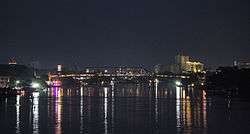Sylhet
| Sylhet | |
|---|---|
| Metropolitan City | |
|
View of Sylhet's skyline and the Keane Bridge from the Surma River at night | |
 Sylhet Location of Sylhet in Bangladesh | |
| Coordinates: 24°54′N 91°52′E / 24.900°N 91.867°ECoordinates: 24°54′N 91°52′E / 24.900°N 91.867°E | |
| Country |
|
| Division | Sylhet Division |
| District | Sylhet District |
| Municipal Board | 1867 |
| Sylhet City Corporation | 9 April 2001 |
| Metropolitan city | 31 March 2009[1] |
| Government | |
| • Type | Mayor–Council |
| • Body | Sylhet City Corporation |
| • City Mayor | Ariful Haque Chowdhury (Bangladesh National Party) |
| Area | |
| • Total | 26.50 km2 (10.23 sq mi) |
| Elevation | 35 m (115 ft) |
| Population (2011) | |
| • Total | 479,837[2] |
| Demonym(s) | Sylheti |
| Demographics | |
| • Ethnicity[3] |
94% Sylheti 6% Bishnupriya Manipuri, Khasi and others |
| Demographics | |
| • Languages | Sylheti, local Bengali and English |
| Time zone | BST (UTC+6) |
| Postal code | 3100 |
| Police | Sylhet Metropolitan Police (SMP)[4] |
| International airport | Osmani International Airport |
| Regional Calling code | +880821 |
| Website |
sylhetcitycorporationbd |
Sylhet /sɪlhət/, also known as Jalalabad, is a metropolitan city in northeastern Bangladesh. It is the administrative seat of Sylhet Division. The city is located on the right bank of the Surma River in northeastern Bengal. It has a subtropical climate and lush highland terrain. \The city has a population of more than 479,837 residents.[5] Sylhet is one of Bangladesh's most important spiritual and cultural centers.It is one of the most important city of Bangladesh just after Dhaka and Chittagong because of many reasons like economy,tourism etc. The city's dargahs draw several thousand devotees each year.
The name of Sylhet is the anglicized form of the ancient Indo-Aryan term Srihatta.[6] In 1303, the Sufi Muslim leader Shah Jalal conquered Sylhet by defeating the local Hindu Raja.[7] Ibn Battuta visited Sylhet in the 14th century and saw Bengali Muslims transforming the region into an agricultural basket.[8] Sylhet was a mint town of the Bengal Sultanate. In the 16th-century, Sylhet was controlled by the Baro-Bhuyan zamindars and became a district of the Mughal Empire.[9] British rule began in the 18th century under the administration of the East India Company. With its ancient seafaring tradition, Sylhet became a key source of lascars in the British Empire. The Sylhet municipal board was established in 1867.[10] Originally part of the Bengal Presidency and later Eastern Bengal and Assam; the town was part of Colonial Assam between 1874 and 1947, when following a referendum and the partition of British India, it became part of East Bengal.[7] The Sylhet City Corporation was constituted in 2001. The Government of Bangladesh designated Sylhet a metropolitan area in 2009.[11]
The hinterland of the Sylhet valley is the largest oil and gas-producing region in Bangladesh. It is also the largest hub of tea production in Bangladesh. It is notable for its high-quality cane and agarwood.[12][13] The city is served by the Osmani International Airport. People from Sylhet form a significant portion of the Bangladeshi diaspora, particularly in Britain.
Etymology
The name Sylhet is anglicized from Srihatta. In Indo-Aryan languages, Sri means prestige or beauty. Hatta (Haat) is a term for a human settlement. In the Mughal Empire's records, Srihatta was used as the name for the district in the Bengal Subah.[14] In British India, Srihatta became known as Sylhet in English.
History
Pre-Islamic
Sylhet was under the realm of the Harikela and Kamarupa kingdoms of ancient Bengal and Assam. Buddhism was prevalent in the first millennium. In the early medieval period, the area was dominated by Hindu principalities, which were under the nominal suzerainty of the Senas and Devas.[15][16]
Islamic
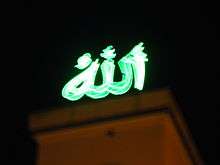
The 14th century marked the beginning of Islamic influence in Sylhet. The Muslim general Shamsuddin Firoz Shah's army defeated the local Hindu Raja Gour Govinda after the raja's persecution of Muslim migrants. The general's army was aided by a Middle Eastern Sufi missionary, Shah Jalal, and 313 of his companions.[17] The area became known as Jalalabad (Land of Jalal) under the Bengal Sultanate. It hosted a mint which produced the taka. When the Moroccan traveler Ibn Batutta visited Shah Jalal in Sylhet in 1345, he noted that the locals embraced Islam due to Shah Jalal's missionary activities."It was by his labours that the people of these mountains became converted to Islam" wrote Battuta in his diary. Bengali Muslims were exploiting the fertile land of Sylhet for agricultural production and enjoyed relative prosperity. The region began to experience an influx of Muslim settlers, including Turks, Arabs and Persians. During the late 16th century, the region was largely controlled by the Kingdom of Bhati. The Mughals subsequently conquered the region. Sylhet became a district headquarter of the Bengal Subah. Its eight mahals included Pratapgarh, Bahua, Jaintia, Habili, Sarail, Laur and Harinagar. The district generated annual revenues of 167,000 rupees.[18]
Colonial
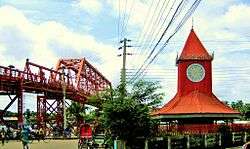
Sylhet came under British administration in 1765. Sylhet was strategically important for the British in their pursuit of conquering Northeast India and Upper Burma. The first commercial tea plantation in British India was opened in the Mulnicherra Estate in Sylhet in 1857.[19] Sylhet was constituted as a municipality in 1867.[20] Despite protests to the Governor of Bengal from its Bengali-majority population, the town was made part of the Chief Commissioner's Province of Assam in 1874 in order to facilitate Assam's educational and commercial development. The Assam Bengal Railway was established in the late 19th century to connect Assam and Sylhet with the port city of Chittagong. In 1905, Sylhet became a divisional headquarter of Eastern Bengal and Assam. In 1912, it was again separated from Bengal and made part of Assam Province. The Muslims of Sylhet generally favored reunion with Bengal. The Bengali Muslim elite in Dacca also vouched for Sylhet's reunion with Bengal. By the 1920s, organizations such as the Sylhet Peoples Association and Sylhet-Bengal Reunion League mobilized public opinion demanding the division's incorporation into Bengal. Nevertheless, the Bengalis of Sylhet were influentially placed in the administration, educational institutions and commercial activities of Assam.[21][22]
Due to the size of Sylhet's Bengali Muslim majority, the All India Muslim League formed the first elected government in British Assam.
The numbers of lascars grew between the two world wars, with some ending up in the docks of London and Liverpool. Sylhet's lascars married English women. During World War II, many fought on the Allied front before settling down in the United Kingdom, where they opened Indian curry cafes and restaurants.[23][24]
In 1947, following a referendum, almost all of erstwhile district of Sylhet became a part of East Bengal in the Dominion of Pakistan, barring its Karimganj sub-division which was incorporated into the Dominion of India. The referendum was held on 6 July 1947. 239,619 people voted to join East Bengal (with the effect of becoming East Pakistan) and 184,041 voted to be part of Assam (i.e. part of India). The referendum was acknowledged by Article 3 of the Indian Independence Act 1947.[25]
East Pakistan
Sylhet became the hub of Pakistan's tea industry after 1947. Pakistan became one of the world's largest tea exporters due to development of plantations in Sylhet by the Ispahani family, James Finlay & Company and others. Burmah Oil discovered natural gas reserves in Sylhet's hinterland in 1955.[26]
Bangladesh
Sylhet was a focal point of East Pakistan's Liberation War, which created the Bangladeshi Republic. It was the hometown of Muhammad Ataul Ghani Osmani, the Commander of Bangladesh Forces. The Battle of Sylhet raged between the Pakistani military and Bangladesh-India Allied Forces from 7 to 15 December 1971, eventually leading to a Pakistani surrender and the liberation of Sylhet.
In 1995, the Government of Bangladesh declared Sylhet as the sixth divisional headquarters of the country.[27] Sylhet has played a vital role in the Bangladeshi economy. Several of Bangladesh's finance ministers have been Members of Parliament from the city of Sylhet. Badar Uddin Ahmed Kamran was a longtime mayor of Sylhet. Humayun Rashid Choudhury, a diplomat from Sylhet, served as President of the UN General Assembly and Speaker of the Bangladesh National Parliament.
In 2001, the municipality was upgraded to the Sylhet City Corporation. It was made a metropolitan city in 2009.[28]
Geography and climate
Sylhet is located at 24°53′30″N 91°53′00″E / 24.8917°N 91.8833°E, in the north eastern region of Bangladesh within the Sylhet Division, within the Sylhet District and Sylhet Sadar Upazila. Sylhet has a typical Bangladesh tropical monsoon climate (Köppen Am) bordering on a humid subtropical climate (Cwa) at higher elevations. The rainy season from April to October is hot and humid with very heavy showers and thunderstorms almost every day, whilst the short dry season from November to February is very warm and fairly clear. Nearly 80% of the annual average rainfall of 4,200 millimetres (170 in) occurs between May and September.[29]
The city is located within the region where there are hills and basins which constitute one of the most distinctive regions in Bangladesh. The physiography of Sylhet consists mainly of hill soils, encompassing a few large depressions known locally as "beels" which can be mainly classified as oxbow lakes, caused by tectonic subsidence primarily during the earthquake of 1762. It is flanked by the Indian states of the Meghalaya in the north, Assam in the east, Tripura in the south and the Bangladesh districts of Netrokona, Kishoregonj and Brahmanbaria in the west. The area covered by Sylhet Division is 12,569 km², which is about 8% of the total land area of Bangladesh.
Geologically, the region is complex having diverse sacrificial geomorphology; high topography of Plio-Miocene age such as Khasi and Jaintia hills and small hillocks along the border. At the centre there is a vast low laying flood plain of recent origin with saucer shaped depressions, locally called Haors. Available limestone deposits in different parts of the region suggest that the whole area was under the ocean in the Oligo-Miocene. In the last 150 years three major earthquakes hit the city, at a magnitude of at least 7.5 on the Richter Scale, the last one took place in 1918, although many people are unaware that Sylhet lies on the earthquake prone zone of Bangladesh.[30]
| Climate data for Sylhet, Bangladesh | |||||||||||||
|---|---|---|---|---|---|---|---|---|---|---|---|---|---|
| Month | Jan | Feb | Mar | Apr | May | Jun | Jul | Aug | Sep | Oct | Nov | Dec | Year |
| Average high °C (°F) | 25.2 (77.4) |
27.1 (80.8) |
30.4 (86.7) |
30.8 (87.4) |
30.8 (87.4) |
30.9 (87.6) |
30.9 (87.6) |
31.6 (88.9) |
31.2 (88.2) |
30.9 (87.6) |
29.2 (84.6) |
26.3 (79.3) |
29.6 (85.3) |
| Average low °C (°F) | 12.9 (55.2) |
14.2 (57.6) |
18.1 (64.6) |
20.8 (69.4) |
22.6 (72.7) |
24.4 (75.9) |
24.9 (76.8) |
25.0 (77) |
24.3 (75.7) |
22.5 (72.5) |
18.4 (65.1) |
14.0 (57.2) |
20.2 (68.4) |
| Average rainfall mm (inches) | 8 (0.31) |
31 (1.22) |
146 (5.75) |
372 (14.65) |
569 (22.4) |
796 (31.34) |
834 (32.83) |
621 (24.45) |
548 (21.57) |
232 (9.13) |
30 (1.18) |
13 (0.51) |
4,200 (165.34) |
| Source: WMO[31] | |||||||||||||
Administration
Sylhet consists of 27 wards and 210 mahallas, it is a small city with an area of 26.50 km².[32] The rapid growth and expansion of Sylhet occurred during the colonial period. Sylhet Municipality was established in 1878. A devastating earthquake demolished almost the entire town on 12 June 1897 following which a modern and European model new town was built on the wreckage. Many new roads were constructed in the late 1890s and Sylhet became really connected to the other parts of the country with the establishment of an extension line of Assam Bengal Railway in 1912–15. From the very beginning of the 20th century, the importance of Sylhet increased with the establishment of the tea industry. In the 1950s and 1960s, rapid urbanisation took place in the town, fostered by the expatriate Sylhetis and the process is still ongoing.
On 10 April 2001, Sylhet was changed to a city corporation from a municipal board, and currently the city is administrated by the Sylhet City Corporation. At present, Sylhet is the district-headquarters as well as the divisional headquarters of the districts of Sunamganj, Habiganj, Moulvibazar and Sylhet District. The Sylhet City Corporation is responsible for the services that are provided within the city which includes traffic, roads, garbage collection, water supply, registrations and many others. The corporation consists of the Mayor and 22 other commissioners, and focuses on the development of the city.[33]
Demographics

As of the 2011 census, the city has a population of 479,837.[2] Together with the metropolitan area it has a population of 2,675,346 as of 2001, constituting 2.06% of the national population.[34] The population growth rate of the city is 1.73%, which has reduced from 1.93% in 1991.[35] As of 2001, It had average literacy rate of 69.73%.[36] The highest literacy rate was 84.24% in Ward 22 and the lowest was 48.15% in Ward 10 (2001). The total number of households in the city was 55,514.[32]
While Standard Bengali is the official language, the Sylheti dialect is the main vernacular spoken in the city.[37][38][39]
Religion
The majority of Sylhetis are Muslims (90%), other religious groups include Hindus (8%), and very few numbers of other religions, mainly Buddhists and Christians (less than 2%).[34] The majority of the Muslims are mainly Sunni Hanafi;[40] and there are significant numbers of people who also follow Sufi ideals, the most influential is the teachings of Maulana Abdul Latif who was from the village of Fultoli, Zakigang. He was a descendant of Hazrat Shah Kamal Quhafa, one of the disciples of Hazrat Shah Jalal.[41]
Diaspora
Thousands of Bangladeshi expatriates have origins in Sylhet Division. The largest numbers of people from Sylhet living abroad is in the United Kingdom , with a population of about 500,000 (95% of the Bangladeshi population).[42][43] Over 200,000 people are Bangladeshi-born, who have migrated to the United Kingdom.[44] They are concentrated in the boroughs of East London, having established themselves within the communities, notably in the vicinity of Brick Lane which has been dubbed as Banglatown.[45][46][47] Sylheti expatriates are known as "Londoni" in Sylhet.[41][48] Many have also immigrated to the United States —they are mainly spread out across the country, but have a large concentration in New York City and Hamtramck, Michigan.[49][50] Many Sylhetis are as well as immigrated to the Canada, France, Australia, Spain, Germany, Sweden and other European countries. Tens of thousands of Sylhetis are also working as guest workers in the Middle Eastern Gulf states.[51][52]
Sylhet has a "Friendship Link" with the city of St Albans in the United Kingdom. The link was established in 1988 when the District council supported a housing project in Sylhet as part of the International Year of Shelter for the Homeless. Sylhet was chosen because it is the area of origin for the largest ethnic minority group in St Albans.[53] In July 1996, the mayor of Sylhet, Badar Uddin Ahmed Kamran, signed the Twinning accord between Sylhet and the London Borough of Tower Hamlets (home to around 55,000 Sylhetis at the time), with the mayor of Tower Hamlets late Albert Jacobs in London.[54] In March 2009, the Mayor of Sylhet, Badar Uddin Ahmed Kamran, signed a Memorandum of Understanding (MoU) to form another Friendship Link between Sylhet and the Metropolitan Borough of Rochdale (home to around 10,000 Sylhetis at present), with the Mayor of Rochdale Cllr Keith Swift at the Sylhet City Corporation
Economy
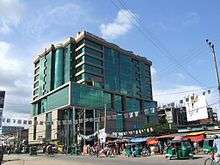
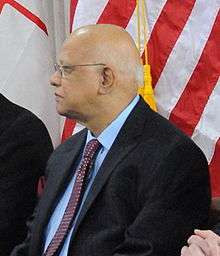
The Sylhet Metropolitan Area is one of Bangladesh's main business centers. Sylhet's economy is closely linked with the Bangladeshi diaspora, especially the British Bangladeshi community. The city receives a significant portion of the country's annual remittances, which have driven growth in real estate and construction.[55] A number of shopping centers, restaurants and hotels have opened as a result. Sylhet also relies on religious tourism, with thousands of devotees visiting its Sufi shrines annually, as well as ecotourism in its broader natural hinterland. Nature resorts have been built in the city's outskirts. Several important Bangladeshi companies are based in Sylhet, including Jalalabad Gas Transmission and Distribution, Sylhet Gas Fields and Alim Industries. Biman Bangladesh Airlines operates several flights from Sylhet to the United Kingdom and the Middle East. Roads connect Sylhet with the Indian states of Meghalaya and Assam.
Sylhet's hinterland plays a vital role in the economy of Bangladesh. It is home to the country's largest natural gas fields, sole crude oil field,[56] largest tea plantations, rubber, palm oil, cane, agarwood[57] and citrus farms. Rice production in the region is one of the country's highest. Heavy industries include power plants, fertilizer plants, cement plants and liquefied petroleum gas plants. Other major industries in the region include ceramics, machinery and equipment, ready-made garments and pharmaceuticals. Most of the tea production in Bangladesh is based around Sylhet, and the industry also has significant exports. The area is also known for producing oranges and other similar fruits. One of these fruit is called "Satkara".
Two Bangladeshi finance ministers from the city have been elected to the Jatiyo Sangshad: Saifur Rahman of the Bangladesh Nationalist Party and Abul Maal Abdul Muhith of the Awami League.
Utility
Sylhet has high rates of Electric power shortage and water shortage. According to the Power Development Board, Sylhet is only receiving 50MW, which is half than the demand of 100MW. The city corporation is also supplying only 22,500 gallons of water, far less than the demand of about 65,000.[58] The major sources of water to the city is the tube wells and the Surma River. There are also high levels of arsenic in the water in Sylhet than in most other regions, this is mainly due to the multiple depth screening in the tubewells.[59] According to the World Health Organization in 1997, about 61% are highly contaminated by arsenic,[60] however in 1999, the percentage of boreholes tested where arsenic levels are above 50 micrograms per litre, was under 25%.[61] There are about 331 registered restaurants in the city, only 15% maintain sanitary facilities and 85% have unhygienic conditions that are unsafe for the public.[62]
Culture
Given its unique cultural and economic development, and linguistic differences (Greater Sylhet region was a part of Assam and Surma Valley State for much of the British Raj in comparison to the rest of Bangladesh), and given that Sylhet has, for most of its recent history, been a region of a larger entity.[63][64] As so many Sylhetis are resident abroad, Sylhet has a major flow of foreign currency from non-resident Bangladeshis. The major holidays celebrated in Sylhet include traditional and religious celebrations, Muslim festivals of Ramadan and then after, Eid-ul-Fitr and Eid-ul-Adha.[65][66] Cultural or nationalistic celebrations include the Language Movement Day, this is where wreaths are laid at the Shaheed Minar paying tribute to the martyrs, the Bangladeshi Independence Day, Victory Day celebrated with parades by school and academies, and the Pohela Baishakh—celebration of the Bengali New Year. Marriages are practised in a traditional Bengali Muslim style, with the gaaye halud, mehendi art and holy prayers.
Sports
Cricket is the most popular Sport in Sylhet. Bangladesh Premier League franchise Sylhet Royals are based in Sylhet Stadium (M.A.G. Osmani Stadium), which was built in 1965 and has a capacity of 15,000 spectators. It is mainly used sporting events. The Sylhet Stadium was renovated in 2013 especially to host matches of 2014 ICC World Twenty20. It is situated near lush green tea gardens on the city fringe. In the National Cricket League Sylhet Division has not won any titles however did win in the One-Day Cricket League in 2001–02 season. Notable players from Sylhet who have played for the Bangladesh national cricket team include Rajin Saleh,[67] Enamul Haque Jr,[68] Tapash Baisya,[69] and Alok Kapali.[70] Chess player Rani Hamid was awarded the FIDE Women's International Master (WIM) title in 1985.
Transport

The main transport systems used in the city are cycle rickshaws, auto rickshaws (mainly known as baby-taxis or CNGs), buses, mini-buses and cars. There are about 80,000 rickshaws running each day. Bus service prices have increased as of 2008, up to 30% higher, prices ranges from Tk4 to 15.95.[71] The Sylhet Railway Station is the main railway station providing trains on national routes operated by the state-run Bangladesh Railway.
The city of Sylhet is served by Osmani International Airport, located at the north of the city. It is Bangladesh's third busiest airport and became an international airport due to the demand of expatriate Bangladeshis and their descendants from the United Kingdom and the United States. The main frequent airlines of the airport are, Biman Bangladesh Airlines,United Airways (BD) Ltd. and domestic flights with GMG Airlines. The airport received its first international arrival on 3 November 2002, with Biman arriving from Kuwait via Abu Dhabi en route to Dhaka.[72] Work started in 2006 to upgrade the airport to international standards, including a new terminal building, a jetway, a taxiway, and expansion of the runway to accommodate wide-bodied aircraft.[73] It was confirmed that in May 2007, Biman will be operating Hajj flights directly from the airport later in 2007.[74]
Education
There are two public universities in Sylhet, including Shahjalal University of Science and Technology and Sylhet Agricultural University.[75] There are some prominent colleges in Sylhet such as Jalalabad Cantonment Public School and College, MAG Osmani Medical College, Sylhet, Sylhet Engineering College,[76] Sylhet Cadet College, Murari Chand College,[77] and Sylhet Polytechnic Institute.
Sister cities
 St Albans, United Kingdom (friendship link)[78]
St Albans, United Kingdom (friendship link)[78] Metropolitan Borough of Rochdale, United Kingdom (Friendship link)[79]
Metropolitan Borough of Rochdale, United Kingdom (Friendship link)[79] London, United Kingdom. (Friendship link)
London, United Kingdom. (Friendship link) Birmingham, United Kingdom (Friendship Link)
Birmingham, United Kingdom (Friendship Link) New York, United States of America. (Friendship link)
New York, United States of America. (Friendship link)
References
- ↑ "Bangladesh clamps down on beggars". BBC News. 2 April 2009. Retrieved 2 April 2009.
- 1 2 "Population & Housing Census-2011" (PDF). Bangladesh Bureau of Statistics. p. 49. Retrieved 15 December 2015.
- ↑ "Current Situation – Past and Present – Sylhet, Bangladesh". Ethnic Community Development Organization. Retrieved 30 May 2009.
- ↑ "Sylhet Metropolitan Police". sylhetmetropolitanpolice.com.
- ↑ http://www.bbs.gov.bd/WebTestApplication/userfiles/Image/National%20Reports/Union%20Statistics.pdf
- ↑ https://global.britannica.com/place/Sylhet
- 1 2 Tanweer Fazal (18 October 2013). Minority Nationalisms in South Asia. Routledge. p. 53. ISBN 978-1-317-96647-0.
- ↑ Perween Hasan (15 August 2007). Sultans and Mosques: The Early Muslim Architecture of Bangladesh. I.B.Tauris. p. 12. ISBN 978-1-84511-381-0.
- ↑ Milton S. Sangma (1994). Essays on North-east India: Presented in Memory of Professor V. Venkata Rao. Indus Publishing. p. 75. ISBN 978-81-7387-015-6.
- ↑ http://www.sylhetcitycorporationbd.org/
- ↑ http://www.sylhetcitycorporationbd.org/index.php/cms/home/
- ↑ https://global.britannica.com/place/Sylhet
- ↑ http://archive.thedailystar.net/newDesign/print_news.php?nid=207067
- ↑ http://en.banglapedia.org/index.php?title=Sarkar
- ↑ Dilip K. Chakrabarti, S. Dara Shamsuddin, M. Shamsul Alam (1992). Ancient Bangladesh: A Study of the Archaeological Sources. Oxford University Press. p. 166.
- ↑ National Institute of Historical and Cultural Research (Pakistan) (1996). Pakistan Journal of History and Culture. National Institute of Historical and Cultural Research. p. 33.
- ↑ Muhammad Mojlum Khan (21 October 2013). The Muslim Heritage of Bengal: The Lives, Thoughts and Achievements of Great Muslim Scholars, Writers and Reformers of Bangladesh and West Bengal. Kube Publishing Limited. pp. 25–. ISBN 978-1-84774-062-5.
- ↑ Milton S. Sangma (1994). Essays on North-east India: Presented in Memory of Professor V. Venkata Rao. Indus Publishing. pp. 75–. ISBN 978-81-7387-015-6.
- ↑ http://soeagra.com/ijert/vol3/10ijert.pdf
- ↑ http://www.sylhetcitycorporationbd.org/
- ↑ Tanweer Fazal (18 October 2013). Minority Nationalisms in South Asia. Routledge. pp. 53–. ISBN 978-1-317-96647-0.
- ↑ Manilal Bose (1989). Social History of Assam: Being a Study of the Origins of Ethnic Identity and Social Tension During the British Period, 1905-1947. Concept Publishing Company. pp. 93–. ISBN 978-81-7022-224-8.
- ↑ Al-Mahmood, Syed Zain (19 December 2008). "Down the Surma – Origins of the Diaspora". Star Weekend Magazine. 7 (49). The Daily Star. Retrieved 28 May 2009.
- ↑ Bengali speaking community in the Port of London PortCities London. Retrieved on 28 May 2009.
- ↑ "Sylhet (Assam) to join East Pakistan". Keesing's Record of World Events. July 1947. p. 8722.
- ↑ http://en.banglapedia.org/index.php?title=Gas,_Natural
- ↑ http://www.londoni.co/index.php/travel-guide/29-location-guide/3-sylhet-bangladesh
- ↑ http://www.sylhetcitycorporationbd.org/index.php/cms/home/
- ↑ Monthly Averages for Sylhet, BGD MSN Weather. Retrieved on 25 May 2009.
- ↑ Siddiquee, Iqbal (10 February 2006). "Sylhet growing as a modern urban centre". Our Cities: 15th Anniversary Special. The Daily Star. Retrieved 25 May 2009.
- ↑ "Climatological Information". WMO. Retrieved 20 January 2015.
- 1 2 "Bangladesh Bureau of Statistics" (PDF).
- ↑ The Sylhet City Corporation Swadhinata Trust. Retrieved on 26 May 2009.
- 1 2 "Sylhet Zila at a Gance" (PDF). Bangladesh Bureau of Statistics. 2007. Archived from the original (PDF) on 24 November 2007. Retrieved 28 November 2008.
- ↑ Bangladesh Bureau of Statistics, Statistical Pocket Book, 2007 (pdf-file) 2007 Population Estimate. Accessed on 29 September 2008.
- ↑ Area, Population and Literacy Rate by Paurashava −2001 Bangladesh Bureau of Statistics. Retrieved on 30 May 2009.
- ↑ "Syloti-Nagri alphabet". omniglot.com.
- ↑ Sylheti unicode chart
- ↑ Christina Julios (2008). Contemporary British Identity: English Language, Migrants, and Public Discourse. Ashgate Publishing, Ltd. pp.40–41. ISBN 978-0-7546-7158-9
- ↑ "Islam in Bangladesh". OurBangla. Archived from the original on 19 February 2007. Retrieved 3 August 2016.
- 1 2 Dr David Garbin (17 June 2005). "Bangladeshi Diaspora in the UK : Some observations on socio-culturaldynamics, religious trends and transnational politics" (PDF). University of Surrey. Retrieved 3 June 2008.
- ↑ Gardner K (1995). International migration and the rural context in Sylhet. New Community 18: 579–590
- ↑ Gillan, Audrey (21 June 2002). "From Bangladesh to Brick Lane". The Guardian. London. Retrieved 28 November 2008.
- ↑ Born Abroad | Bangladesh BBC News. Retrieved on 19 May 2009.
- ↑ Spitalfields and Banglatown (London Borough of Tower Hamlets) accessed 1 November 2007 Archived 25 October 2007 at the Wayback Machine.
- ↑ Baishakhi Mela 2009 (London) – Nukul Kumar – Sylhet Jila Shobche Boro Channel S (via YouTube). 10 May 2009. Retrieved on 24 May 2009.
- ↑ Mela Magic Tower Hamlets Council. 11 May 2009. Retrieved on 24 May 2009.
- ↑ "Genetics, Religion and Identity: A Study of British Bangladeshis – 2004–2007" (PDF). School of Social Sciences – Cardiff University – funded by the Economic and Social Research Council. Retrieved 15 September 2008.
- ↑ Kaari Flagstad Baluja (2003). Gender Roles at Home and Abroad: The Adaptation of Bangladeshi Immigrants. LFB Scholarly Pub. (University of Michigan). pp. 77. ISBN 1-931202-51-6.
- ↑ Census Profile: New York City’s Bangladeshi American Population Asian American Federation of New York Census Information Center. 2005. Retrieved on 27 May 2009.
- ↑ Eve Gregory, Ann Williams (2000). City literacies: learning to read across generations and cultures. Routledge. pp. 39. ISBN 978-0-415-19116-6.
- ↑ Robin Cohen (1995). The Cambridge survey of world migration. Cambridge University Press. pp. 360. ISBN 978-0-521-44405-7.
- ↑ Sylhet, Bangladesh St. Albans District Council
- ↑ Sylhet Partnership Photo Gallery Swadhinata Trust. Retrieved on 25 May 2009.
- ↑ http://www.bbc.com/news/uk-england-berkshire-16190888
- ↑ http://en.banglapedia.org/index.php?title=Haripur_Oilfield
- ↑ http://archive.thedailystar.net/newDesign/print_news.php?nid=207067
- ↑ Iqbal Siddiquee (5 May 2009) Power, water crises grip Sylhet city The Daily Star. Retrieved on 29 May 2009.
- ↑ Alan H. Welch, Kenneth G. Stollenwerk (2003). Arsenic in Ground Water: Geochemistry and Occurrence. Springer. pp. 254.
- ↑ Arsenic poisons Sylhet water The Independent. 11 September 1997. Retrieved on 29 May 2009.
- ↑ Fluoride and Arsenic in Drinking Water World Health Organization (2008). Retrieved on 29 May 2009.
- ↑ Study of Water Quality in Sylhet City and its Restaurants: Health Associated Risk Assessment Tehran University of Medical Sciences. Retrieved on 29 May 2009.
- ↑ Not all Bangladeshis oppose the filming of Brick Lane The Guardian (by Iqbal Ahmed) 20 July 2006
- ↑ 'You sanctimonious philistine' – Rushdie v Greer, the sequel The Guardian (by Paul Lewis) 29 July 2006
- ↑ Security beefed up in Sylhet for Eid New Age Metro. 22 October 2006. Retrieved on 25 May 2009.
- ↑ Marika McAdam (2004). Bangladesh. Lonely Planet. pp. 145.
- ↑ Players and Officials – Rajin Saleh Cricinfo. Retrieved on 27 May 2009.
- ↑ Players and Officials – Enamul Haque jnr Cricinfo. Retrieved on 27 May 2009.
- ↑ Players and Officials Hasibul Hussain who was the opening bowler in the 1999 World Cup – Tapash Baisya Cricinfo. Retrieved on 27 May 2009.
- ↑ Players and Officials – Alok Kapali Cricinfo. Retrieved on 27 May 2009.
- ↑ Sylhet city bus services hike fares on whim New Age Metro. 4 November 2008. Retrieved on 25 May 2009.
- ↑ Weekly Holiday (22 November 2002). "Biman launches Kuwait-Sylhet flight". Aviatour.
- ↑ "Osmani Airport expansion work begins in July". The Daily Star. 13 May 2004.
- ↑ "Runway expansion at Osmani Airport nearing completion". New Age. 12 May 2007. Retrieved 14 May 2007.
- ↑ Shahjalal University of Science and Technology Varsity Admission. Retrieved on 25 May 2009.
- ↑ "Sylhet Engineering College". The Daily Star. 9 November 2008. Retrieved 25 May 2009.
- ↑ Islam, Mohammad Shafiqul (25 March 2007). "Inter University Debate Competition: Metropolitan University Team Champion". The Daily Star. Retrieved 25 May 2009.
- ↑ Friendship link
- ↑ "Rochdale Township Committee" (PDF). Rochdale Borough Council. Retrieved 22 April 2016.
External links
| Wikimedia Commons has media related to Sylhet. |
![]() Sylhet travel guide from Wikivoyage
Sylhet travel guide from Wikivoyage
